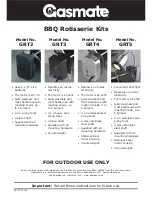
ROTISSERIE COOKING
Rotisserie cooking produces foods that are moist,
flavourful and attractive, as the turning food self
bastes. Although the rotisserie is best for larger
pieces of meat or poultry, nearly anything can be
used if prepared properly.
Balancing the Food
The item that requires the most attention in
rotisserie cooking is balancing the food. The
rotisserie must turn evenly otherwise the
stopping and starting action will cause the food to
cook unevenly and possibly burn the heavier side.
The easiest foods to balance are those of uniform
shape and texture. To test if the food is balanced
correctly when secured, place the ends of the
rotisserie skewer loosely in the palms of your
hands. If there is no tendency to roll, give
the spit a quarter turn. If it’s still stable give
it a final quarter turn. It should rest without
turning in each of these positions. It can then be
attached to the barbecue.
Poultry
When using poultry, truss the birds tightly so that
wings and drumsticks are close to the body of the
bird. The cavity of the bird maybe stuffed prior
to this if you wish. Pull the neck skin down and
using a small skewer fix to the back of the bird.
Push the rotisserie skewer through lengthwise,
catching the bird in the fork of the wishbone.
Centre the bird and tighten with the holding
forks. Test the balance as described above.
Rolled Meat
A rolled piece of meat only requires the rotisserie
skewer to be inserted through the centre of
the length of meat then secured and balanced.
Unboned Meat
For meats which are unboned it is best to secure
the rotisserie skewer diagonally through the
meaty sections.
When to Use Foil
If protuding bones or wings brown too quickly
cover with pieces of foil.
SETTING UP THE BARBECUE
When rotisserie cooking the majority of heat will
come from an indirect souce. In other words the
burners at each end of the barbecue are lit and
the food is placed centrally with no direct heat
source underneath it.
Place the barbecue’s cooking pan in the central
location which will catch any drips from the food
above. This can then be used to make gravies
and other sauces to accompany the cooked meats.
Place the hood down over the food when you start
to cook.
For foods with little fat you may wish to cook
them directly over one or two burners depending
on the length of the food, to give a charred effect.
This should only be done towards the end of the
cooking for no longer than 10-15 minutes. Do
not attempt this with foods that are fatty as this
will cause flare-ups and excessive smoke. If you
wish to cook foods directly open the hood of the
barbecue.
COOKING TIMES
This will vary according to the type and weight of
food you are cooking. Insert a meat thermometer
into the centre of the meat (avoiding bone) which
will provide a temperature guide for you.
The cooking times on a rotisserie will be
approximately the same as for oven cooking.
Parts List:
No.
Description
Qty
1
Motor Bracket
1
2
1/2” screw
4
3
Washers
4
4
Nuts
4
5
Half size spit rod 42.5cm
1
6
Half size spit rod 42.5cm
1
7
Skewer with thumbsrews
4
8
Collar with thumbscrew
1
9
Shaft Bush
1
10
Handle
1
11
AC/DC motor
1
12
Spit extension rod
1
13
Motor rod
1
14
Shaft bracket
1
15
Shaft spacer
1






















